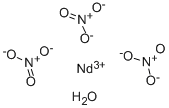Palladium(II) nitrate dihydrate
Synonym(s):Palladium dinitrate hydrate
- CAS NO.:32916-07-7
- Empirical Formula: 2NO3.Pd.2H2O
- Molecular Weight: 266.46
- MDL number: MFCD00011169
- EINECS: 681-918-4
- SAFETY DATA SHEET (SDS)
- Update Date: 2024-07-26 15:15:06

What is Palladium(II) nitrate dihydrate?
The Uses of Palladium(II) nitrate dihydrate
Palladium(II) nitrate dehydrate is used as a reactant for:
- Doping activated carbon for catalysis
- Catalytic use of hydroxyapatite (HAP) supported Pd nanoclusters in the hydrolysis of ammonia-borane.
It′s used as catalyst for:
- Selective hydrogenation of 1-heptyne and napthalene
- In highly porous coordination polymer MIL-101 support.
It may also be used as a reactant for:
- Preparation of platinum-palladium/carbon alloy nanocatalysts for methanol-tolerant oxygen reduction reaction in fuel cells
- Synthesis of Cu-Pd alloy thin films on Ti substrates by co-electrodeposition of Pd and Cu from nitrate-base electrolytic baths
- Preparation of palladium catalyst supported on vertically aligned multi-walled carbon nanotubes for microwave-assisted Heck reactions of p-iodonitrobenzene with styrene and Et acrylate
- Preparation of di-phenyl sulfide-modified Pd/TiO2 catalysts for acetylene hydrogenation
Properties of Palladium(II) nitrate dihydrate
| Density | 1.118 g/mL at 25 °C |
| storage temp. | Store below +30°C. |
| form | Liquid |
| Sensitive | Hygroscopic |
| Merck | 14,6992 |
| Exposure limits | ACGIH: TWA 2 ppm; STEL 4 ppm OSHA: TWA 2 ppm(5 mg/m3) NIOSH: IDLH 25 ppm; TWA 2 ppm(5 mg/m3); STEL 4 ppm(10 mg/m3) |
Safety information for Palladium(II) nitrate dihydrate
| Signal word | Danger |
| Pictogram(s) |
 Flame Over Circle Oxidizers GHS03  Corrosion Corrosives GHS05  Exclamation Mark Irritant GHS07  Environment GHS09 |
| GHS Hazard Statements |
H271:Oxidising liquids;Oxidising solids H290:Corrosive to Metals H302:Acute toxicity,oral H314:Skin corrosion/irritation H410:Hazardous to the aquatic environment, long-term hazard |
| Precautionary Statement Codes |
P210:Keep away from heat/sparks/open flames/hot surfaces. — No smoking. P260:Do not breathe dust/fume/gas/mist/vapours/spray. P273:Avoid release to the environment. P280:Wear protective gloves/protective clothing/eye protection/face protection. P303+P361+P353:IF ON SKIN (or hair): Remove/Take off Immediately all contaminated clothing. Rinse SKIN with water/shower. |
Computed Descriptors for Palladium(II) nitrate dihydrate
Palladium(II) nitrate dihydrate manufacturer
ARRAKIS INDUSTRIES LLP
1Y
Phone:+91-7499586750
Whatsapp: +91- 7499586750
product: PALLADIUM NITRATE 99%
New Products
4-Fluorophenylacetic acid 4-Methylphenylacetic acid N-Boc-D-alaninol N-BOC-D/L-ALANINOL Tert-butyl bis(2-chloroethyl)carbamate 3-Morpholino-1-(4-nitrophenyl)-5,6-dihydropyridin- 2(1H)-one Furan-2,5-Dicarboxylic Acid Tropic acid S-2-CHLORO PROPIONIC ACID ETHYL ISOCYANOACETATE 2-Bromo-1,3-Bis(Dimethylamino)Trimethinium Hexafluorophosphate (6-METHYL-[1,3]DITHIOLO[4,5-b]QUINOXALIN-2-ONE INDAZOLE-3-CARBOXYLIC ACID 4-IODO BENZOIC ACID (2-Hydroxyphenyl)acetonitrile 4-Bromopyrazole 5,6-Dimethoxyindanone 2-(Cyanocyclohexyl)acetic acid 4-methoxy-3,5-dinitropyridine 2-aminopropyl benzoate hydrochloride 1-(4-(aminomethyl)benzyl)urea hydrochloride diethyl 2-(2-((tertbutoxycarbonyl)amino) ethyl)malonate tert-butyl 4- (ureidomethyl)benzylcarbamate Ethyl-2-chloro((4-methoxyphenyl)hydrazono)acetateRelated products of tetrahydrofuran








You may like
-
 Palladium nitrate Matrix Modifier Solution CASView Details
Palladium nitrate Matrix Modifier Solution CASView Details -
 PALLADIUM NITRATE 99%View Details
PALLADIUM NITRATE 99%View Details
32916-07-7 -
 Palladium(II) nitrate, dihydrate, ~40% Pd basis CAS 32916-07-7View Details
Palladium(II) nitrate, dihydrate, ~40% Pd basis CAS 32916-07-7View Details
32916-07-7 -
 Palladium(II) nitrate dihydrate CAS 32916-07-7View Details
Palladium(II) nitrate dihydrate CAS 32916-07-7View Details
32916-07-7 -
 Palladium(II) nitrate dihydrate CAS 32916-07-7View Details
Palladium(II) nitrate dihydrate CAS 32916-07-7View Details
32916-07-7 -
 1975-50-4 98%View Details
1975-50-4 98%View Details
1975-50-4 -
 14714-50-2 (2-Hydroxyphenyl)acetonitrile 98+View Details
14714-50-2 (2-Hydroxyphenyl)acetonitrile 98+View Details
14714-50-2 -
 118753-70-1 98+View Details
118753-70-1 98+View Details
118753-70-1
Statement: All products displayed on this website are only used for non medical purposes such as industrial applications or scientific research, and cannot be used for clinical diagnosis or treatment of humans or animals. They are not medicinal or edible.